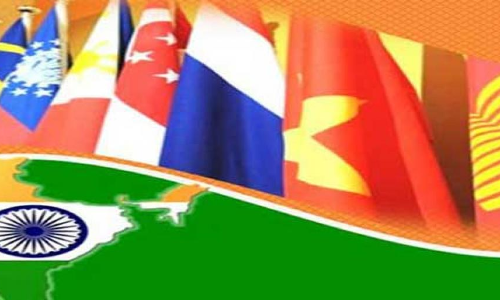Demystifying foreign policy of India

•The Look East policy has emerged as a major thrust area of India’s foreign policy in the post-Cold War period. It was launched in 1991 by the then Narasimha Rao government to renew political contacts, increase economic integration and forge security cooperation with several countries of Southeast Asia as a means to strengthen political understanding.
- The Look East policy has emerged as a major thrust area of India’s foreign policy in the post-Cold War period. It was launched in 1991 by the then Narasimha Rao government to renew political contacts, increase economic integration and forge security cooperation with several countries of Southeast Asia as a means to strengthen political understanding.
- India’s Look East policy is aimed at greater economic alignment and an enhanced political role in the dynamic Asia–Pacific region in general and Southeast Asia in particular.
- The Look East policy is pursued to make India an inalienable part of Asia–Pacific’s strategic discourse. Hence, the Look East policy marks the beginning of a vibrant relationship on the economic, political and strategic fronts.
- The economic potential of this policy is also emphasised to link to the economic interests of the North-eastern region as a whole.
- The beginning of the early 1990s was marked by a transformation in the international political economy, contributed by the end of the Cold War and the resulting spread of globalisation.
- Globalisation of world economies intensified international competition and has given rise to a new wave of regionalism.
- During this time India, like many developing countries, faced many challenges—both internally and globally. Internally, the country was unsettled by social unrest, serious political instability and poor economic performance.
- After the disintegration of the Soviet Union, New Delhi lost a major economic partner and its closet strategic ally.
- India cannot look towards West Asia and Africa for intensive economic cooperation, as the countries of this region look up mainly to the West.
- During this period, India has got attracted to the high-performing economies of East Asia.
- Forced by the economic crisis and the dire need of Foreign Direct Investments (FDIs) for rapid economic development, India had enunciated the Look East policy in 1991 and was determined to work with the spirit of regional economic cooperation with her Eastern neighbours.
First phase of look east policy
- The first phase of India’s Look East policy was ASEAN-centred, and focused primarily on trade and investment linkages.
- The second phase, which began in 2003, is more comprehensive in its coverage, extending from Australia to East Asia, with ASEAN as its core.
- The new phase marks a shift in focus from trade to wider economic and security cooperation, political partnerships, physical connectivity through road and rail links.
- In India’s effort to look East, the Northeastern region has become a significant region due to its geographical proximity to Southeast Asia and China.
- India’s search for new economic relationship with Southeast Asia is now driven by the domestic imperative of developing the Northeast by increasing its connectivity to the outside world.
- Instead of consciously trying to isolate the Northeast from external influences, as it had done in the past, New Delhi has now recognised the importance of opening it up for commercial linkages with Southeast Asia.
- Over the time, policy-makers, bureaucrats and intellectuals have attributed the numerous armed separatist struggles and political instability in the Northeastern states to the region’s underdevelopment and weak economic integration with mainland India.
- As part of the efforts to integrate the region with the rest of India, developmental funds were poured in and emphasis was laid on infrastructural development.
- However, the region still has the problem of underdevelopment and faces the problem of a growing and expanding security apparatus. Moreover, there is a relocation of factories and industries towards northern and western India, and hence the cost of transportation of goods to Northeast India has increased.
- Therefore, the existing policy of development of the Northeastern region needs to be reoriented if its stated objectives have to be fulfilled in due course.
- Look East policy, which identifies Northeast India as the gateway to the East, is a major initiative that promise a new way of development through political integration of this region with the rest of India and economic integration with the rest of Asia, particularly with East and Southeast Asia.
- Taking into account its geographical proximity, its historical and cultural linkage with Southeast Asia and China and the primary objective of the Look East policy, it is being widely stated that the Look East policy would result in the rapid development of the region as it promises increased trade contacts between the Northeastern region and Myanmar, China and Bangladesh.
- The policy also has the potential of solving the problem of insurgency, migration and drug trafficking in the region through regional cooperation.
- On the other side, there is pessimism that the policy of integrating Northeast India with its Eastern neighbours would lead to dumping of cheap foreign goods, and the region’s own industries being adversely affected by it.
- The region is also being perceived as just a transit region without bringing economic development to the region, as it has no adequate industrial infrastructure to produce goods which can be exported to these countries. There is also a concern that such integration will develop further the feeling of alienation of the people and the region itself would drift away from the mainstream Indian politics.
Act east
- Under the present government, India’s Look East policy has morphed into a proactive Act East policy, which envisages accelerated across-the-board engagement between the two growth poles of a vibrant Asia.
- India’s growing relations with the 10-nation ASEAN grouping are at the heart of this Asian relationship. Prime Minister Narendra Modi in his maiden trip to Myanmar on November, 2014, to attend his first India-ASEAN summit and the 18-nation East Asia Summit, unveiled India’s new “Act East Policy”, and convinced his Southeast Asian counterparts that his government is serious about boosting ties with the region.
Commerce, Culture and Connectivity (Three Cs)
- Commerce, Culture and Connectivity are the three pillars of India’s robust engagement with ASEAN. In the economic arena, the India-ASEAN relations are poised to scale new frontiers.
- The two sides have signed an India-ASEAN Free Trade Agreement (FTA) in services and investments recently. It includes specific recommendations to advance ASEAN-India economic relations over the next few years, including establishing a special purpose vehicle for project financing, building information highways, and inviting ASEAN countries to participate in India’s ongoing economic transformation.
- For the Northeast to serve as a bridgehead to the country's eastern neighbourhood, there has to be a comprehensive connectivity strategy for the region.
- Such a strategy would have three interlinked components. The first would be to improve connectivity between the Northeast and the rest of India; the second would be to enhance connectivity within the Northeast and the third would be to improve existing and establish new cross-border transport and communication links with neighbouring countries.
- These three components need to be pursued in tandem if the full benefits of Act East policy are to be realised.
- In the first category, the existing highway and rail-link needs to be upgraded significantly to enable much higher load-carrying capacity and speedier transit. We need to construct modern expressways and a high-speed rail freight and passenger corridor to more closely integrate the Northeast with the rest of India.
- This will also enable Northeast produce to find ready markets in the country itself and to compete for exports.
Intra-regional connectivity within the Northeast is sparse, poor in quality and over stretched
- The existing branch rail lines and roads from the rail heads to various state capitals are unable to cope with the increase in both freight and passenger traffic.
- Currently, travel among state capitals of the Northeast is difficult and time consuming.
- There has to be a master plan for linking all the Northeastern states together with a network of road, rail and air links.
- One should also fully utilise the potential of inland water transport using the rivers which crisscross the region. Bangladesh is also increasingly open to reviving the old river navigation routes, which were the main transport links in undivided eastern India.
- Without this Act East policy would not bring economic benefits to the region as it would only bring heavy influx of imports from neighbouring countries without much encouragement to local resource based production and access to the larger Indian and export markets.
Cross-border connectivity
- It has been on the government's agenda for several years, but has made only slow progress. There is an ambitious Trilateral Highway Project to link India, Myanmar and Thailand, with possible extensions to Laos and Vietnam. The multi-nodal transport corridor linking the Myanmar port ofSittwe with India's Mizoram, using both river and road transport is under implementation.
- There are a number of road, river and rail projects in the pipeline with Bangladesh, Nepal and Bhutan.
- In addition to physical infrastructure, it is also important that we adopt the most modern processes to facilitate the smooth crossing of state and national borders by both goods and people.
- Only then would transaction costs be reduced significantly and raise the competitiveness of our products.
- It is important for India to invest in infrastructural development projects in the Northeast region and beyond its borders.
Bangladesh-China-India-Myanmar corridor (BCIM)
- At a strategic level, the proposed Bangladesh-China-India-Myanmar corridor (BCIM) is bound to bring India and Bangladesh closer and will enhance bilateral relations relating to trade and movement of goods.
- BCIM economic corridor is also very important as it places the North-East as a crucial link to achieve regional economic cooperation via land of the North-Eastern region. Complementing this, the Bay of Bengal Initiative for Multi-Sectoral Technical and Economic Cooperation (BIMSTEC) can also act as a good framework for regional integration.
- BIMSTEC can open up ample trade and economic opportunities between India’s neighbours like Nepal,Bhutan and Bangladesh and also with the countries of The Association of Southeast Asian Nations like Myanmar and Thailand.
- Were these intended projects to actually materialise, then a densely interconnected and economically vibrant sub-regional economic zone would emerge, with the Northeast as its hub.
- The bigger idea behind investing in CMLV is not only to tap these markets but also larger markets like the US with which the group has entered into trade pacts such as the TPP (Trans-Pacific Partnership).
Challenges in realising these ambitions
- India’s ability to pursue a more ambitious role in the Asia-Pacific will also face domestic constraints.
- A prolonged period of lower growth, if happens, may reduce India’s capacity to commit resources to the region, it will also diminish its credibility in the eyes of regional partners.
- India is still in the early stages of developing its ability to project and sustain its naval presence beyond the Indian Ocean, and continued increases in the naval budget and improvements to India’s defence infrastructure will be necessary to achieve this.
- As a geographic outsider to the Asia-Pacific, India will continue to rely on its partners, particularly in Southeast Asia, to project power east of Malacca, located in the southern region of the Malay Peninsula, further reinforcing the need for it to prove itself a credible partner in the first place.
- India under Modi is likely to pursue a more ambitious role in East and Southeast Asia centred on practical partnerships with Japan, Vietnam, and Australia, and multilateral engagement with ASEAN.
- India’s partners in the region can expect greater Indian involvement in multilateral maritime security initiatives, particularly in the areas of humanitarian assistance and disaster relief, transnational crime, and joint bilateral naval exercises.
- However, India will be unlikely to engage in any security initiatives that could be perceived as threatening or containing China.
- In the near term, it would not be realistic to expect India to take an active position on East Asia’s maritime territorial disputes, beyond its declared support for principles such as freedom of navigation.
- In the past, India has neglected to articulate a clear vision for its strategic ambitions in East and Southeast Asia.
- Historically it has suffered from strategic timidity and poor defence planning that has impeded its ability to integrate itself into the Asia-Pacific.
- To establish the seriousness of India’s commitment to the region, the Modi Government must demonstrate that Act East is more than just a rebranding of an existing policy. Perseverance is a must here and is likely to pay off because of two positive factors.
- First, the likely emergence of India as the fastest growing major economy. Secondly, India already has some reliable partners, such as Singapore and Vietnam, among ASEAN countries.
- And there is a palpable unease about China’s claim on what it calls the SouthChina Sea. In order to preclude further inertia, India will need to move quickly to outline a clear agenda for deepening economic, institutional, and defence links with the region that go beyond what has been pledged by previous governments.
- If the Modi Government is able to achieve this, then India has the potential to assume a role as a consequential strategic player across the wider Indo-Pacific.
Next Story

















